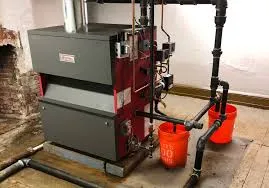The Ultimate 6 Types of Steam Boilers
The Ultimate 6 Types of Steam Boilers

Steam Boilers And Its Types
A steam boiler generates energy by heating water and producing steam. It is a heat exchanger with a combustion chamber and a water container that produces steam for external use. Steam boilers are available in various sizes, from extremely small to huge, for more demanding applications. To heat water, a steam boiler burns fuel.
Steam is created when heat and water combine. Three types of heat are used to make steam: radiation, convection, and conduction. The structure, mobility, tube type, fuel type, and pressure produced by steam boilers identify them. Boilers were as efficient as contemporary boilers when they were first developed, but they were hazardous due to a lack of control systems.
A boiler's size, fuel, and dimensions vary depending on the work it is meant to do and the industry in which it is employed. Electricity, wood, natural gas, coal, and fossil fuels are examples of fuels. The cost, environmental friendliness, and efficiency of the fuels varied.
Biomass fired reciprocating grate steam boiler
As the need for electricity and power generation has grown, alternative fuels such as biomass and garbage or trash have been created. Here are the various types of boilers that have arisen over time:
- Electric Boilers
Electric boilers create heat using electric components, a speedier and more efficient heating technology. It is an environmentally friendly, cleaner technology since it does not require fuel. Electric boilers last longer, require less cleaning and require no maintenance. The one element that must be managed with electric boilers is scale accumulation in the water reservoir.
- Hot Water Boilers
Hot water boilers are tanks that use heat to circulate water for heating purposes. They are composed of stainless steel, cast iron, aluminium, and steel and can handle high temperatures and pressures. Hot water boilers, such as fire or water, are classified according to their tube systems. Tubes in fire tube hot water boilers are immersed in water, and heat travels through the tubes, heating the water surrounding them. Water flows inside the tubes of water tube boilers as they heat up.
- Low-Pressure Boilers
Low-pressure steam boilers transmit heat at pressures ranging from 10 to 15 psi and temperatures ranging from 300° F (149° C). This type of boiler is employed when a stable temperature is required, and there is no requirement for fast temperature changes. The popularity of low-pressure steam boilers stems from their ability to provide steam much faster than high-pressure steam boilers.
- Gas Boilers
Gas steam boilers are more efficient than regular boilers since they are fuelled by natural gas or propane. A gas boiler's fuel is piped into the boiler from an outside source that is directly linked to the boiler. The design of a gas steam boiler determines how heat is distributed. Gas steam boilers are suitable for industrial and low-pressure applications.
- Oil Boilers
Oil steam boilers work on the same principles as gas boilers, except oil is ignited in the combustion chamber instead of gas. The exchanger that warms the water is heated by the burning oil. Oil steam boilers have an efficiency of more than 90%. Though they are more costly than gas steam boilers, they often last twice as long. One issue with oil boilers is the requirement for an oil tank, either inside or outside, that must be supplied regularly to provide a consistent fuel supply.
- High-Pressure Boilers
Excessive pressure is generated by high-pressure steam boilers to power equipment and machinery. A high-pressure steam boiler's force and power are generated by a pump that drives high-pressure steam into the circulation system. A boiler must be able to produce pressure between 15 psi and 800 psi at temperatures over 250° F (121° C) to be categorised as a high-pressure steam boiler. High-pressure steam boilers are routinely monitored for pressure and temperature for safety and efficiency. High-pressure loads in high-pressure steam boilers can be batch or continuous, with batch being used for short-term demand and continuous being used for long-term demand.
One of the most common uses for these steam boilers is to power turbines that generate energy. A big and powerful boiler may produce up to 225,000 pounds of steam per hour at 900 psi. A boiler system of that scale may produce 20 megawatts of power. Thanks to technological advancements and inventions, steam boilers may be constructed to save energy while creating them.
-
Electric Steam Boiler Manufacturers: Efficient Industrial SolutionsNewsAug.21,2025
-
Efficient Waste Heat Boilers: Energy Recovery SolutionsNewsAug.19,2025
-
Industrial Thermal Oil Boilers | Efficient & Reliable HeatingNewsAug.18,2025
-
Electric Steam Boiler Manufacturers: Efficient & Reliable SolutionsNewsAug.17,2025
-
Electric Steam Boiler Manufacturers: Efficient Industrial SolutionsNewsAug.15,2025
-
Leading Electric Steam Boiler Manufacturers for IndustryNewsAug.14,2025


